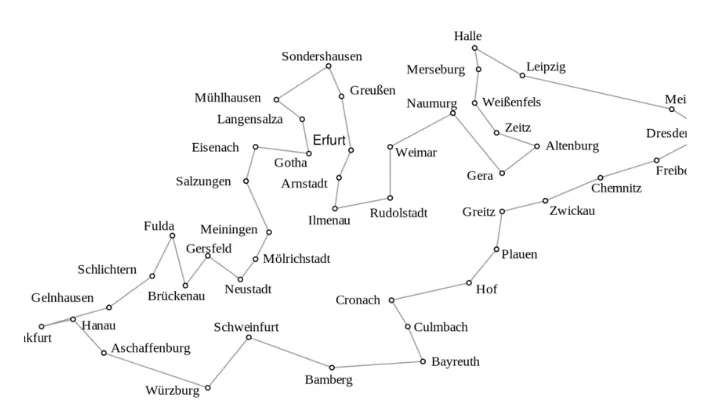Subject matter experts create countless numerical problems by shuffling the numbers. But the travelling salesman problem algorithm, abbreviated as (TSP) is a standard sum. Therefore, Students have many mathematical problems solved using formulae, operations, and theorems. However, this specific sum alleviates the reasoning for many other numerical problems like the drilling problem of Printed circuit boards. It is an algorithmic sum in computer science engineering.
Question for the Traveling Salesman Problem:
Here is a list of cities and the distance between them. Find the shortest distance route for a salesperson to visit each city once, starting from and returning to the first city. One can calculate the solution by different methods, but the most common ones are here for help.
- Dynamic Programming
- Simulated Annealing
- Genetic Algorithm
- Ant Colony Optimisation
There are many other ways to get the required result. So in this article, we focus on the method to solve dynamic programming examples to reach the end solution. Thus, Computer science learners want to achieve perfection in their work. Hence, they connect with technical experts to get hands-on experience with the logical concepts and practical applications of theories.
Student take Java assignment help services from leading agencies. Because they offer informative and affordable study guidance at different learning levels. Hence, Dynamic programming is widely applicable in Java to solve its summations.
What is dynamic programming?
A computer programming method to break an algorithm into smaller components and find individual optimum solutions. Because to get the highest and lowest value of the query is the way to define dynamic programming. Further In 1950, Richard Bellman devised the concept of blending mathematical optimization and computer programming.
It is suitable for finding answers to overlapping minor divisions of lengthy problems. Thus, it helps to solve complicated problems. A few dynamic programming examples are as below.
- Finding the minimum distance between two points
- Maximum possible outcomes of a die roll
- Creating an optimum strategy for a game
Engineering students use the above methods to perform several mathematical problems in engineering, like creating a sequence of interconnected outcomes. Therefore, Student finding the optimal combinations of decisions, and more. Thus, Computing is a passion for many youngsters.
It is strategically different from other non-technical subjects. Therefore, if they want guidance on any topic while creating a project, they can opt for an expert from EssayCorp computer science faculties, such as the Java assignment help experts.
Finding a solution for the Traveling Salesman Problem algorithm
According to graph theory, Traveling Salesman Problem algorithm requirement makes a closed graph, or it mimics Hamilton Cycle ( A cycle is a tour in which the initial vertex repeats at the end), and therefore this particular graph is called Hamilton Graph.
The above figures represent two routes starting from one and returning at one. Thus, the route selection makes the journey a short tour.
The rule for writing Dynamic Programming is as follows-
F(Sn, DN) = RN+ FN-1*(Sn-1, Dn-1)
Where-
F (SN, DN ) = Return on n-stage of the value input
SN= Initial Conditions
SN-1 = Final Condition
DN= Decision made at each stage.
DN-1= Decision made at the final stage
RN= Return function
FN= Final function
Implementation
- Determine the basis of the Hamilton graph using the-
f(i, ∅)=∁i,1;2≤i≤n)
- Calculate f(i,s) using
F(i,s)=min{cij+f(j,s-{j})
- Calculate the equation of a recursive relationship by obtaining previous step results.
f(1,v-1)=min(ci,k+f(K,V-{1,K})
- After calculating the above step, the recursive relationship will give the shortest rule.
EXAMPLE-
Implementation of Travelling Salesman Problem in C++
#include<stdio.h>
#include<conio.h>
#include<iostream>
using namespace std;
int c = 0,cost = 999;
int graph[4][4] = { {0, 20, 25, 30},
{20, 0, 45, 35},
{25, 45, 0, 40},
{30, 35, 40, 0}
};
void swap (int *a, int *b)
{
int temp;
temp = *a;
*a = *b;
*b = temp;
}
void copy_array(int *x, int n)
{
int i, sum = 0;
for(i = 0; i <= n; i++)
{
sum += graph[x[i % 4]][x[(i + 1) % 4]];
}
if (cost > sum)
{
cost = sum;
}
}
void permute(int *x, int i, int n)
{
int j, k;
if (i == n)
{
copy_array(a, n);
}
else
{
for (j = i; j <= n; j++)
{
swap((x + i), (x + j));
permute(x, i + 1, n);
swap((x + i), (x + j));
}
}
}
int main()
{
int i, j;
int a[] = {0, 1, 2, 3};
permute(a, 0, 3);
cout<<“minimum cost:”<<cost<<endl;
getch();
}
Importance of Traveling Salesman Problem
It is the ideal process for calculating an optimal route. Therefore, it applies to many practical solutions. Interestingly, it gives the shortest path and the minimum timing also.
As a result, it shows the least expense in which the journey completes. Hence, students pursuing computer science engineering practice several sums related to TSP.
Learners have several tasks during academic years. Because they construct project reports, statistical reports, presentations, and practicals.
Moreover, they assemble data from various sources to create an exclusively informative document. So, the traveling salesman problem algorithm has applications in multiple fields.
- Optimizing data travel between multiple nodes
- Delivering food and newspaper
- Routing
- Planning
- Going for a logistical approach
- Making schedules
There are many computer science and engineering students need help doing different mathematical problems in engineering because get fewer marks in the subjects.
Therefore, they find some learned faculty to guide them on the in-depth meaning of the concepts and clear their subject-related issues.
How do technical experts solve mathematical problems in engineering for students?
EssayCorp gives a boundless extension of study guidance providers for learners. Also, we support students in several subjects with science, management, nursing, and Java assignment help services. Thus, our panel of writing professionals is leading individuals from prominent universities.
Therefore, students can depend on their talents and decade of experience. They derive every data from reliable information sources. Similarly, they outline the document with the perfect referencing styles like Harvard, Vancouver, Chicago, and Oxford.
Thus, students get homework designed in preferable formats from our Java assignment help writers. So, we have several factors that compel students to choose our services.
- 24x7 response
- Highly qualified professionals
- Multiple subjects experts at one click
- Track of documents' progress
- Student-friendly prices
- Safe and secure payment modes
- Strict standards obeying of university rules
- On-time supply of write-ups
Conclusion:
Students can go for games, music, dance, or study for career designing because academics is no more a nightmare. So, our team of professionals gives you top-quality study materials throughout the year.
Plus, we guarantee to return your 100% money for uncopied
instructions. So, whenever you want advice or suggestions on any topic of any subject, contact EssayCorp on WhatsApp or by Email.



